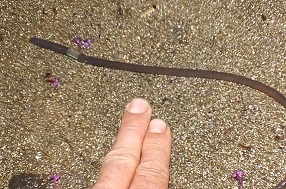Amynthas agrestis
The Amynthas agrestis is more wildly known as the Asian jumping worm. It is an invasive species that is very ruthless and out competes local native earthworms. It takes over a forest floor section by section till there is nothing left much the same as locus do. Amynthas agrestis is in the Kingdom Animalia, Phylum, Annelida, Class, Clitellata, Order Haploxida, and Family Megascolecidae.

Some Characteristics of Amynthas agrestis: They are very active. They slither like a snake which is uncharacteristic of most other annelids. Clitellum is light in contrast. Iridescent, and violet colors in direct sunlight. They will shed their tails to escape predation just like their close relative the Alabama Jumper (amynthas gracilis). Their vermicast is very large and has the resemblance and characteristics of cooked ground beef. On the surface this annelid seems to be a good little vermicomposter but as we dig deeper into the subsurface we find that they are having a huge devastating effect on forest floor substrate and the vital nutrients that make up the food web of the forest as a whole.
"https://www.youtube.com/embed/Ca7n3Gf3xX4"
In the Northeast during the last ice age around 10,000 years ago massive glaciers scraped the bedrock bare as they receded over hundreds of years and in doing so also cleared out any native earthworms we originally had. That being said we have brought new earthworms over from the old world and though there is an on going debate whether they are a help or a hindrance, for the most part we assume at the moment that they are doing more good than bad. Now the Amynthas agrestis that is from Japan and Korea is much different than our other visitors and as part of their name suggests, they are very aggressive and much different than the European earthworms. One of many differences is their reproduction process. Most earth worms are hermaphroditic which simply means that they all have male and female organs. However, they still need a friend to complete the reproductive process. Amynthas agrestis on the other hand are parthenogenic, meaning they’re all females who then have the ability to make cocoons filled with hundreds of little ones that are also female and there for never needing to mate with another and so with only one worm you are gifted with an infestation. They also mature twice at twice the rate of European earthworms, finishing two generations per season instead of just one. Their population density also gets greater than other worms. Their also a much larger species growing to lengths of 8 inches long. That leads to a massive worm biomass that will destroy all biomass in its path. This includes lawns as well as the roots of annuals, perennials, and shrubs. In the forests, they destroy the native wildflowers, wiping out such plants as trillium, bloodroot, Jack-in-the-pulpit, lady slipper, and other understory plants. As these understory plants disappear they take with them the understory songbirds with them. “As Amynthas agrestis infestation removes organics from soil, the soil becomes clumpy and granular and prone to compaction and erosion. Forest soils actually subside, exposing tree roots. Wisconsin Department of Natural Resources invasive species specialist Bernie Williams stated “Their introduction into our state poses a huge threat to the future of our forests.”
“Amynthas agrestis can be distinguished from other worms by their darker color (in general), and by the band near their middle called a clitellum. In most worms it’s puffy, and similar in color. In crazy worms it’s even with the body, and milky white to gray. Mature size and behavior also set them apart. Crazy worms are transplants, and that’s how they often spread. Whether in a potted plant from a garden center or a gift from a South Carolina relative, these monsters hitchhike long distances with transplants. They also move from infested areas, mostly in southern states, in shipments of mulch.
There are two ways of telling if your potted plant harbors dangerous fugitives. One is to turn it upside-down and gently remove the root ball. If crazy worms are present, the roots, as well as some potting soil, may be missing. The thing is, there may only be young crazy worms present, or very few, so damage might not be evident. A better solution is a mustard solution. Mix a gallon of water with one-third cup of ground yellow mustard seed, and pour this slowly into the soil. It won’t hurt the plant, but worms (even “good” ones) will come to the surface and you can check for miscreants.”
Because of their acrobatics, crazy worms are valued as fishing bait. This is illegal in most places, but it does happen. To be safe, anglers should securely cover bait containers, and destroy all unused bait by placing it on bare concrete and stepping on it. With a presence in Wisconsin and Minnesota, Amynthas agrestis is hardy to USDA Zone 4 and possibly colder.
Sources: https://urbanwormcompany.com/crazy-worm-amynthas-agrestis New York State Urban Forestry Council. http://nysufc.org/worms-bad-urban-forest/2017/10/14/#more-3574
“Amynthas Agrestis.” INaturalist.org, www.inaturalist.org/taxa/364093-Amynthas-agrestis.